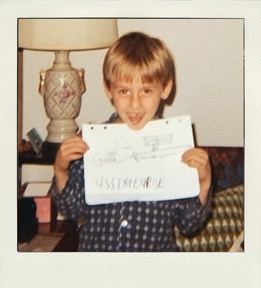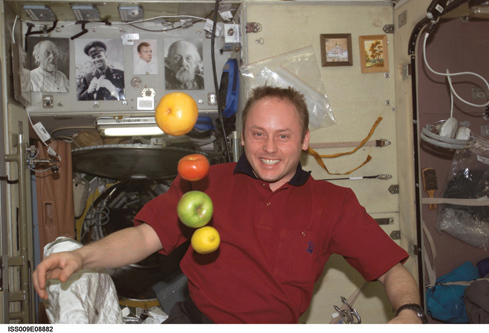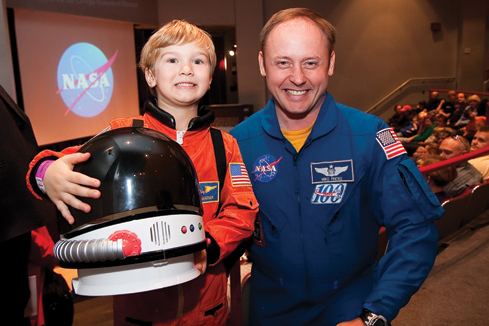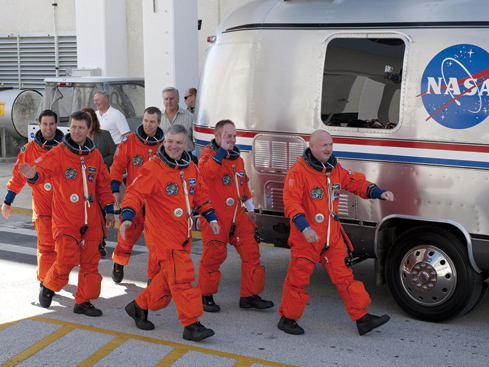|
Spacewalker
Fresh off his latest space mission, native son Mike Fincke's infectious love for all things science helps inspire the next generation of big dreamers.
By Jennifer Bails
Mike Fincke recalls an exchange with fellow NASA astronaut John Young, who was the ninth person to walk on the moon as commander of the Apollo 16 mission in 1972.
Fincke was readying to launch aboard the Russian Soyuz rocket to spend six months on the International Space Station (ISS)—more than five times the total days Young had logged in space on six different flights. Both acknowledged it was a long time to live in orbit roughly 220 miles above the Earth’s surface.
“I sure hope you like it!” the veteran astronaut exclaimed.
That was Fincke’s biggest worry. He knew he could handle the trip; he had been training for this opportunity his entire life. The question became: would it live up to his dream?
“My biggest surprise, then, was how much I liked it,” he says. “3-2-1 … Liftoff! Eight and a half minutes and we’re in space. We’re weightless. We’re giggling ‘cause it’s so exciting!” continues Fincke. “The spacecraft started to roll, and my window was the first to see planet Earth. I couldn’t believe it. To see the curvature of the planet below and blues you can hardly even describe with any language. I loved it! The wonder of looking at our planet from space … it was just awesome. I never got tired of it.”
Fincke took 21,000 photos of Earth from space, including many shots of western Penn-sylvania, where he grew up in the northern
blue-collar suburb of Emsworth.
 |
|
Fincke was drawn to science at a young age.
|
He also looked deep into the cosmos for the first time.
“I saw the southern stars for the first time for real, and it brought me back to all the southern constellations that I learned about when I was at the Buhl Planetarium,” says Fincke. As a boy, he would watch in awe as the old Buhl Planetarium and Institute of Popular Science’s Zeiss Model II Star Projector conjured up the heavens in its Theater of the Stars.
“It opened my mind to leave my little village of Emsworth and to think about the whole universe,” he says.
Today the massive Zeiss projector is on display in the first-floor atrium of Carnegie Science Center, while upstairs, hundreds of children journey through the night sky every day in the new state-of-the-art Buhl Digital Planetarium.
Perhaps the next Mike Fincke is among them.
As one of only three Americans who have spent more than a year in space, Fincke is living proof that with a lot of hard work and a little luck, dreams really can come true. “If this kid from Emsworth can walk aboard the International Space Station, anyone can do anything,” he says, flashing his near-permanent smile.

Mike Fincke, aboard the Zvezda Service Module of the International Space Station (ISS) in 2004, shows off the impact-and fun-of zero gravity in space.
Out of this world
Four years after his first spaceflight in 2004, Fincke returned on the Soyuz for another six-month stint aboard the ISS. And on May 16, the Air Force colonel and aeronautical engineer went back to space for a third time on the final voyage of space shuttle Endeavour, earning him the distinction as the American with the most time logged in space.
The eyes of the world were on the 16-day Endeavour mission, not in small part because its commander was astronaut Mark Kelly, husband of Congresswoman Gabrielle Giffords, who is recovering from brain injuries sustained in the Tucson shooting in January. But any time Fincke is in space, all eyes at Carnegie Science Center are glued on him.
“Mike made contact with us in 2003 prior to his first mission,” says Ron Baillie, the Science Center’s The Henry Buhl, Jr., Co-Director. “He wanted to thank us for the inspiration he had received as a young boy going to the Buhl. And since that first contact, Mike has been a great friend to the Science Center and a staunch supporter of our mission.”
“Mike thanks us for inspiring him,” adds Ann Metzger, also The Henry Buhl, Jr., Co-Director, “but, in reality, all of our staff are in awe of what he’s accomplished and how very much he cares about all of the young boys and girls who visit the Buhl Digital Planetarium today.”
As Mission Specialist No. 1, Fincke sat on the flight deck in the cockpit to assist with launch and landing. He also completed a number of spacewalks, adding to the 26 hours and 12 minutes of “extra-vehicular activity” he logged during his previous expeditions.
"We've all had the special teachers, the meaningful mentors that we remember. And so my goal now is to be that kind of person and help the people who come after me."
-Mike Fincke
The Endeavour flight—which carried six astronauts, a cargo bay full of spare supplies, and a $2 billion astrophysics experiment to the ISS—marked the penultimate
mission of America’s 30-year, nearly $200 billion space shuttle program. This latest mission delivered the Alpha Magnetic Spectrometer—the most expensive piece of equipment a space shuttle has ever carried—to the ISS. Designed to capture space particles, like antimater and dark matter, scientists hope it will lead to a better understanding of how the universe began and evolved. NASA plans to launch shuttle Atlantis in early summer before retiring the fleet to make way for future programs aimed at visiting an asteroid by 2025, and then possibly target missions to Mars. Meantime, NASA will rely on Russia’s Soyuz rockets to ferry astronauts to the ISS until commercial spacecraft become available.
At one point during this historic flight, Fincke wore a t-shirt that reads, “I love Carnegie Science Center, Pittsburgh, Pa.” The space-faring shirt will become part of a future Science Center display of Fincke’s memorabilia—such as flight suits, gloves, watches, flipcharts, and mission books—that he plans to donate to the Science Center, says director of science and education John Radzilowicz, who traveled with his family to Kennedy Space Center in Florida to watch the Endeavour launch at Fincke’s invitation. (But two weeks of delays in the shuttle’s launch due to a faulty heater system forced Radzilowicz to miss liftoff.)
“These items are customized especially to Mike,” Radzilowicz explains. “He could either store the materials at home or find a place where they could have an impact. We’re honored to be his first choice.”
The Science Center plans to make Fincke’s personal space items part of a new permanent astronomy exhibit called SpacePlace, which will feature two life-sized scale models of the ISS along with a zero-gravity visitor experience. It’s meant to complement the Science Center’s marquee astronomy programs, workshops, and classes for students, teachers, and the generally curious.
“We’ve wanted to have a major, ‘gee whiz’ astronomy gallery since we moved into this building 20 years ago,” Radzilowicz says. “It will be the perfect place to display the memorabilia that Mike is donating.”
"If this kid from Emsworth can walk aboard the International Space Station, anyone can do anything"
-Mike Fincke
NASA and Carnegie Science Center have been longtime partners, too. This past spring, the space agency even held a town hall meeting in the Science Center’s Works Theater to gather feedback on its strategic plan for the next decade of planetary science. Fincke has played an important role in fostering this collaboration, returning to the Science Center time and again to give back generously to the institution he credits with introducing him to the wonders of the universe.
He volunteered to narrate the video portion of It Came From Outer Space, the Science Center’s live demo show that engages students as ISS cadets on a research mission, where they do fiery rocket chemistry, grow towering crystals, and more. He’s given presentations numerous times, including as the keynote speaker at the 2005 Carnegie Science Awards. And he initiated and participated in two downlinks from the ISS, live video chat sessions with hundreds of local students who packed the Science Center for the opportunity to ask him questions about life in space (e.g., How do you go to the bathroom? “With great care.” Have you seen anything strange? “No little green men to report yet.”)
“We’ve all had the special teachers, the meaningful mentors that we remember,” says Fincke. “And so my goal now is to be that kind of person and help the people who come after me.”
The will, and a little luck
Fincke’s humility, sense of humor, and infectious love for his work give him an amazing rapport with kids. “It sounds like a joke, but it’s not—Mike is the most down-to-earth astronaut I’ve ever met,” Radzilowicz says.
During every visit to the Science Center, he thanks the staff for their efforts to generate public interest in science. He even phoned Radzilowicz directly from space to express his gratitude for help in arranging the NASA downlinks. In turn, Fincke has a loyal fan club.
“If there ever was an experience at the Science Center that inspired me, it was
getting to meet Mike Fincke,” says Mike Hennessey, program development coordinator for science and education at the Science Center. “He’s just so exuberant and bubbles over with such enthusiasm, not only for the space program but for informal science education. He sees its importance as a necessary part of kids’ development.”
For Fincke, that education began at age 3, when he remembers watching astronauts walk on the moon. “I knew right then and there that was something I wanted to do,” he says. As the oldest of Edward and Alma Fincke’s nine children, he worked tirelessly to pursue this calling. He received a scholarship to attend private high school at Sewickley Academy, helping to pay his tuition with a paper route. Although money was tight, the family made regular weekend visits to the old Buhl Planetarium and Carnegie Museum of Natural History. “I was a lucky kid,” he says.

The Emsworth native visits Carnegie Science Center to encourage kids to dream big.
Sewickley science teacher Susan Zawacky says it was clear right away that Fincke was a bright, motivated student, unafraid to challenge her with tough questions. Even so, it was hard not to think about the long odds that he would ever become an astronaut.
“He was very forthright about what he wanted to do, and I don’t know what everyone else thought, but my reaction was to say, ‘Uh-huh, sure, Mike,’” Zawacky says. “But it wasn’t just that he talked about becoming an astronaut—he had a game plan that turned out to be extremely realistic.”
The next step in that plan was to attend the Massachusetts Institute of Technology on an Air Force ROTC scholarship. Fincke graduated from MIT in 1989 with dual degrees in aeronautics and astronautics and Earth, atmosphere, and planetary sciences, and then participated in a summer exchange at the Moscow Aviation Institute. He also studied Russian, anticipating correctly that NASA might one day join forces with the world’s other major space program.
From there, Fincke earned a master of science in aeronautics and astronautics from Stanford University before entering the United States Air Force with ambitions of becoming a fighter pilot.
“After six or seven months, the Air Force and I both agreed that I wasn’t going to be God’s gift to aviation … I washed out of pilot training,” he recounts. “Can you imagine how disappointing that was?”
Mike Fincke (second from right) walks with fellow crew members of space shuttle Endeavour before departing for launch pad 39A at the Kennedy Space Center.
He was reassigned as a space systems engineer and space test engineer, logging upwards of 1,000 flight hours in more than 30 different aircraft. In 1996, he got the call from NASA to report to Johnson Space Center in Houston, where he now lives with his wife, Renita, and their three children. He completed two years of astronaut training and then bided his time performing technical duties.
His window of opportunity finally opened six years later. The shuttle fleet had been grounded after the Columbia disaster in 2003, so NASA was using Russian spacecraft to transport crews to the ISS. Fincke’s Russian skills and qualifications as a Soyuz co-pilot landed him a space on Expedition 9, which launched from Kazakhstan on April 18, 2004.
“Here it was,” recalls Mike. “My dream came true … Everything from then on was just gravy.”
Except, he notes, the birth of his children. His older daughter, Tarali, was born while he was aboard the ISS (his flight schedule had been moved up by six months). Her name is derived from the Sanskrit word for star. His son is named Chandra, which means moon, and the youngest is Surya, referring to the Hindu god of the sun.
On October 12, 2008, Fincke returned to space aboard the Soyuz on Expedition 18, while back on Earth his hometown football team began their run to the Superbowl XLIII championship. The local hero became a YouTube sensation as he waved his weightless Terrible Towel from the ISS, declaring that outer space was Pittsburgh Steelers country.
Fincke’s most recent mission was his first aboard a NASA space shuttle, which he says will always hold a significant place in the annals of human spaceflight. As the program ends (Endeavour is headed for display at the California Science Center), the 44-year-old astronaut hopes to help write the next chapter of space exploration. He believes there will be colonies on the moon and that Mars is well within our reach—and perhaps even other solar systems.
“I firmly believe that human beings will not stay long on planet Earth and that there’s a whole universe out there to explore,” he says. “The sky’s the limit, and I really hope our country understands the value of exploration and the value of the unknown.”
Maybe years from now, Fincke will be joined on this mission by another young dreamer who looks up at the stars inside Carnegie Science Center and has the courage to dream big.
|






